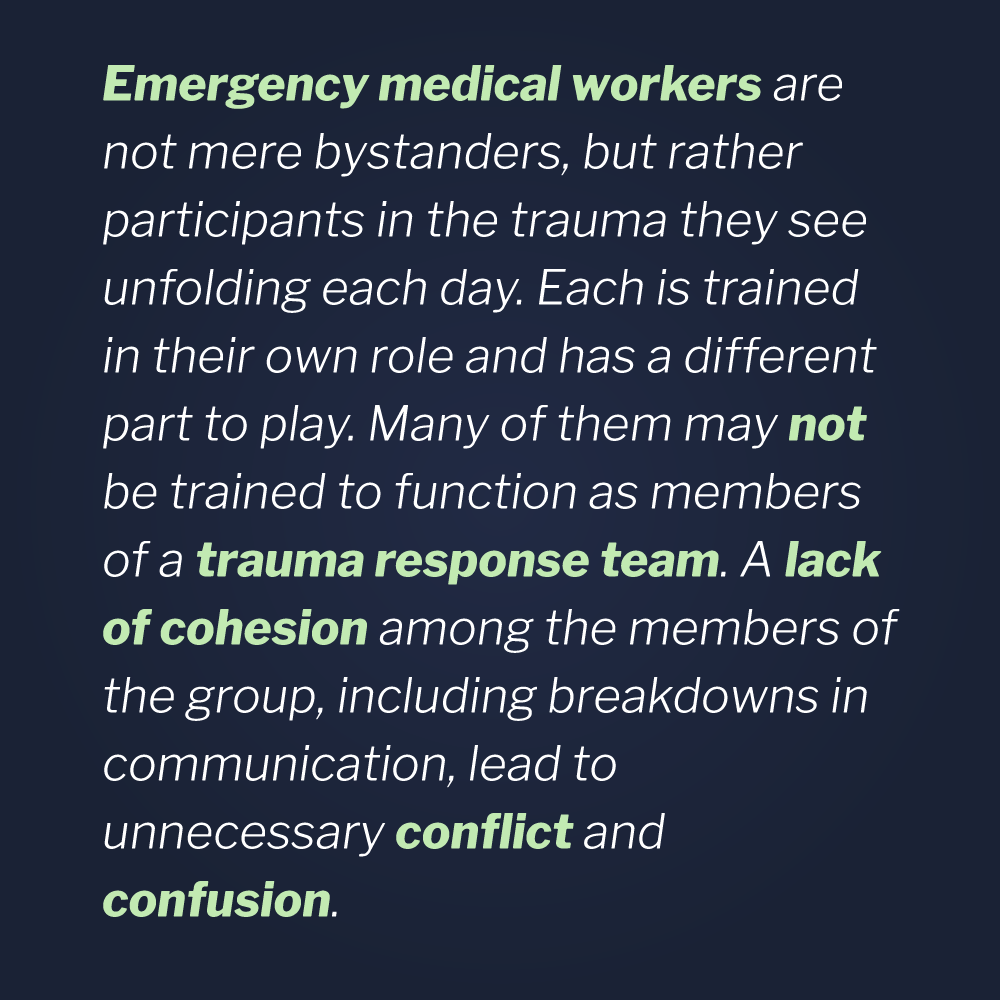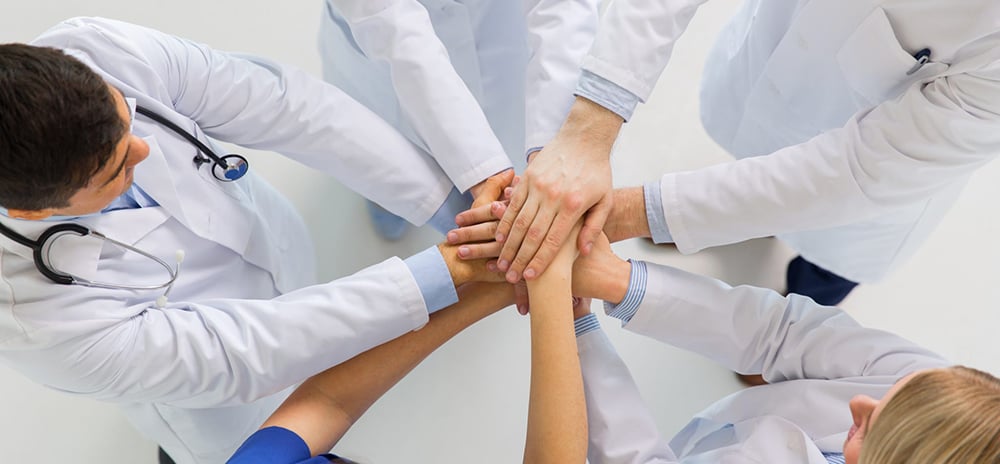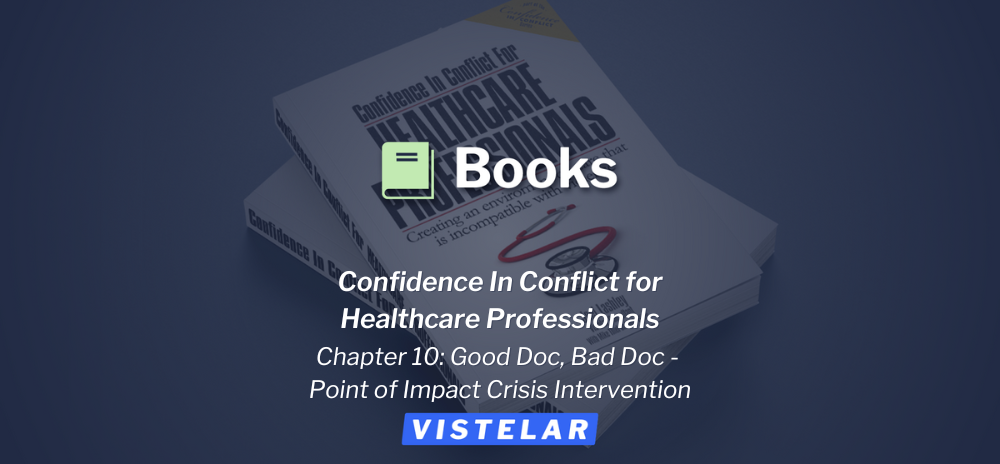Everyday, hospital emergency departments (ED) receive patients and visitors experiencing extreme levels of emotional and/or physical trauma, whether it’s at a level one trauma center in Chicago or at a small critical access hospital (CAH) with less than 25 beds in the middle of America’s corn belt.
No matter the size or location of your hospital, everyone who works in emergency medicine is expected to respond, rather than react to severe physical and emotional trauma. That’s an important distinction because a response is learned, prepared, and predictable, while a reaction is natural, unprepared, and unpredictable. And the only way to ensure a learned response is through task-specific training.
Respond, Don’t React
Emerson is an experienced trauma nurse from rural Wisconsin, but she started her career at a busy ED in Chicago, fresh after graduating with her BSN degree. Working as part of a trauma team, there were times when she had undoubtedly seen more blood, death, and grief in a single day than most people in America see in a lifetime.
She could recall some of her busiest days when gunshot victim after gunshot victim rolled through the door, between heart attacks, suicide attempts, strokes, overdoses, sexual assaults, and traffic accidents, mixed in with all of those patients waiting to be seen for everything from hemorrhoids to cold sores because no one is ever really turned away from an ED.
On one such day, Emerson had already worked 10 hours when the second ambulance carrying a child with a gunshot wound rolled through the door. The first one was a young boy in his early teens who arrived unresponsive and intubated, with a serious gunshot wound to the abdomen. The second was an older teenager who had been shot in the leg.
Emerson recognized the smirk on the second teenager’s face while he was being rolled into the ED, as she had seen that smirk a couple times before on young men’s faces after they had been shot during another episode of street violence. She thought that maybe they were smiling because they had cheated death or because the gunshot wound was a badge of honor that brought the bearer a lot of street cred. Whatever the reason, that smile usually meant they were going to be okay.
As a result of the two gunshot victims that had already arrived by the afternoon, police and security officers were swarming around the ED, which always made her feel safer. Victims of shootings were often followed to the hospital by angry and upset family members. Worse yet, sometimes they were followed by fellow gang members and/or members of rival gangs.
During her 10-year stint at that busy urban Chicago medical center, there were many days when Emerson was threatened and/or physically assaulted by patients and visitors. Over those 10 years, she had filed more work-related injury reports than she could recall. Eventually, after coming to believe that injuries from violence were part of her job, she stopped reporting them at all unless they resulted in time off from work.
She also discovered that she wasn’t always emotionally safe from other nurses and physicians, who sometimes lashed out at each other, perhaps as a result of their own stress and emotional trauma. Unfortunately, healthcare had already long ago earned a reputation for bullying and disrespect among coworkers – something they forgot to mention when Emerson was in nursing school.
Even so, Emerson never felt closer to anyone than she did to some of the nurses, doctors, and others she worked with in the ED, probably because they worked shoulder to shoulder, day in and day out, exposed to the worst of the worst injuries on the front lines of medicine. When it mattered, she could always count on her coworkers to do their jobs. They were a family. But they were a family that was dysfunctional at times. How could they not be, considering what they dealt with everyday?
Emerson and her fellow care providers understood that people who don’t work in healthcare consider emergency medical workers to be only bystanders to all that violence and pain, as if being in the middle of all of it each day wasn’t enough to negatively impact a person’s well-being.
Emergency medical workers, from paramedics, to respiratory technicians, to healthcare security officers are not mere bystanders, but rather participants in the trauma they see unfolding each day. Each is trained in their own role and each has a different part to play. That said, many of them may not be trained specifically to function as members of a trauma response team. Sometimes a lack of cohesion among the members of the group, including breakdowns in communication, lead to unnecessary conflict and confusion.
not mere bystanders, but rather participants in the trauma they see unfolding each day. Each is trained in their own role and each has a different part to play. That said, many of them may not be trained specifically to function as members of a trauma response team. Sometimes a lack of cohesion among the members of the group, including breakdowns in communication, lead to unnecessary conflict and confusion.
Just as things were getting settled with the two gunshot victims, the ambulance bay doors burst open again. Two EMTs rolled in with a large combative male on a gurney, who was struggling and cursing loudly. They had managed to apply restraints to both arms in the back of the ambulance, but his legs were free and he was kicking wildly, knocking over an IV pump in the hallway. A nurse instinctively ran over to help, but the man kicked her in the chest, knocking her to the ground, where she bumped her head.
A security officer ran over to try and restrain the patient’s legs. Then another nurse tried to help but she wound up with a dislocated finger that took her out of the action. One of the ambulance crew then grabbed the other leg, but now the gurney was stuck in the middle of the hallway. The security officer and the EMT struggled to restrain the big man’s powerful legs.
To make matters worse, the gurney was up too high, resulting in an imbalanced center of gravity. This put them at a great disadvantage for gaining leverage and shortened their reach, causing them to work twice as hard to manually restrain the kicking patient. They had to try and manage all of that, while also trying to keep the imbalanced gurney from toppling over.
Besides needing to lower the gurney by using one of the foot pedals, they also obviously needed more help and a restraint kit. But with two nurses already injured, no help was immediately available. Nor was there any help coming, as the security officer rushed in to help before calling for back-up and now couldn’t get a free hand to call on his radio.
The nurse who had just been kicked was being examined by one of the doctors, who ordered a c-collar before moving her to a gurney. The security officer shouted for someone to call security for more help and to bring a restraint kit. After much indecision about who should call, someone finally picked up a phone and called security, but not on the emergency line, so the call was placed on hold. When the security dispatcher finally took the call, the caller said they needed security fast, but forgot to mention the restraint kit.
Just then, another gurney came rolling in behind them carrying a patient who had just been revived with a portable cardiac defibrillator. They stopped in the middle of the hallway behind the other gurney that was carrying the combative patient who was still thrashing and screaming. Amid the chaos, no one had noticed the timid and frightened middle-aged woman who wandered in through the ambulance bay doors behind the gurney. Clutching her purse, she just stood behind her husband’s gurney in the hallway. Finally, the paramedics with the cardiac patient had to back up and go the long way around to get to the room being prepared for them.
The cardiac team was called to assemble STAT and the ED began to flood with people from all departments bringing assets to the heart attack patient’s side. Quickly, a med cart, a crash cart, and a portable x-ray machine arrived.
Meanwhile, while some ED med-techs were loading the injured nurse onto a backboard, three more security officers arrived to assist with the restraint of the combative patient. Finally learning they would need a restraint kit, they called for one to be dispatched immediately. The two restraint kits normally stored in the ED had been used previously and were sent to sterile processing for cleaning, so another one would have to be brought to the scene, causing an even greater delay in getting the much-needed equipment.
Emerson was on standby to assist with the cardiac patient when she noticed the heart patient’s wife standing in the hall. Emerson introduced herself and explained what was happening with her husband. The woman wanted to stay nearby, so Emerson got her a chair to sit outside the room and waited for the ED social worker to arrive and take her in hand.
The room looked chaotic to the woman’s untrained eyes, as a dozen people were crammed into the tiny exam room, along with an x-ray machine and carts full of meds and equipment. The people working to save her husband could be heard chattering and doctors were shouting orders for medications and procedures.
Meanwhile, the security team had finally managed to apply all four points of restraint to the combative patient across the way and roll him into a room. A nurse then ran over to the heart patient’s room and asked if anyone was available to assist with the other patient, and a discussion broke out about who could break away from the cardiac patient. Then suddenly the physician working on the frightened woman’s husband shouted, “Everybody just shut the hell up!”
Emerson knew instantly that the doctor was just trying to restore voice discipline, so she could better manage communication and run her team. But when she looked at the woman she saw the terror that had swept through her after hearing the doctor’s words and the anger in her voice.
Suddenly, the woman sprang to her feet and shouted, “Oh my God! He’s going to die, isn’t he?”
“We don’t know that!” Emerson shouted back instinctively, not knowing how else to answer her.
Shocked by what she had just heard and by Emerson’s seemingly panicked response, the woman screamed and crumpled to her knees in the hallway, leaving Emerson struggling to help her stand. The social worker finally arrived and helped Emerson get her back in her chair.
Not sure what to do next, Emerson ran over to the combative patient to assist, as no one else had broken away when they called for help. The security team was standing by, while healthcare staff was attempting to treat. The patient was still clearly agitated and continued to threaten anyone who got near him. Not sure what to do yet, Emerson tried to soothe and reassure the patient until she was instructed what to do by the lead nurse.
But while she attempted to communicate with the patient, the three security officers were loudly telling him to calm down and to stop resisting. When he would move, they would place their hands back on him and shout for him to stop moving. Emerson noticed that this seemed to agitate the patient even more.
The more he shouted and cursed at them the more the security officers and one of the nurses shouted back, telling him to relax and stop threatening and cursing. But that seemed to have the opposite effect. He would shout back at them, saying, “Don’t f***ing tell me to calm down! Get your f***ing hands off me! I’ll kill you!” The more they talked the more agitated he became, pulling harder against the restraints and flopping ever more violently on the gurney. This frightened Emerson, as she had seen very violent patients break free from those restraints before.
Emerson shook her head and stopped to comprehend what had just happened. Within a matter of a few short minutes, two patients had arrived – one combative and another in cardiac distress. Not so unusual a thing for an Emergency Department in a big city. But within those few short minutes, they had gone from two new patients to five, while simultaneously losing two team members to job-related injuries.
Also, a patient’s spouse, who had arrived frightened but calm, was now hysterical and being wheeled into an exam room for treatment. The combative patient was still combative and unresponsive to medications at this point. The cardiac patient was being treated and seemingly in good hands, but if you didn’t know better, you certainly wouldn’t think so. What she also probably didn’t comprehend, was that at least one, probably two, and possibly three security officers were tied up unnecessarily and like many of the other team members, causing as much harm as good.
Emerson had made her mind up at that very moment, about something she had been thinking about a long time. “It’s time for a change,” she thought. When she arrived home after 15 long hours of working and commuting, she decided to update her resume starting first thing in the morning. She was going to look for a quiet little hospital in the country to finish out her career.
Emerson was excited on her first day at the tiny Critical Access Hospital (CAH) out in the country. Critical Access Hospitals are small rural hospitals of 25 beds or less, located in areas of the country that are far remote from big cities and their 200+ bed hospitals. Her first few days were heavenly, as she hadn’t seen a single gunshot wound. Most of the patients seemed nice, but people were people and they had some tough customers too. But nothing she couldn’t handle, she thought.
Then one day, an ambulance came in through the back, with a pulseless and non-breathing patient. The EMTs had started CPR and were breathing for her, using an AMBU bag. Quickly the team assembled and they went to work on the woman.
Just then, the receptionist pushed open the ED doors from the lobby and shouted, “We need help out here!” The charge nurse asked Emerson to break away and go and see what the problem was. Emerson followed the receptionist to the lobby, where she led her behind the registration and triage counter. On the other side of the counter was a large man in overalls and a trucker hat, yelling, “Where the hell is my wife!”
“What’s your wife’s name, Sir?” Emerson asked.
“They took her in the ambulance! She better be okay! I know what you people are like!”, he said angrily. Emerson also noticed that his words were slurred and that he appeared unbalanced. Then the smell of alcohol hit her.
“We just had an ambulance come in. If you can tell me your wife’s name, I’ll get you some information right away and the doctor will speak with you when he has a moment,” Emerson continued.
Then the man placed his hands on the counter, leaned in toward her, and said in an eerily quiet but angry and threatening tone, “You’ll f**king let me see her now, b*tch, or you’ll be sorry. You people already killed my mom!”
With the counter between them, Emerson stood her ground and replied, “Now, Sir, I need you to calm down and…”
Just then, the man shouted, “Don’t f**cking tell me to calm down, b*tch!”, then lunged over the counter and grabbed Emerson by the front of her scrub top. Within a second, she was on the floor at his feet. Then the receptionist instinctively got behind him and tried to pull him off of Emerson, but he struck back at her with a hammer fist and knocked her to the floor.
The receptionist fought to remain conscious, while she prayed silently for help to come. But everyone in the ED was in the trauma room working to save the life of the attacker’s wife. So at that moment, these two women were alone and at the mercy of their attacker. And no one knew they were in trouble. And no one knew that they were fighting for their lives. For one brief moment, Emerson wished she was back in Chicago because at least she knew they wouldn’t be alone.
Thankfully, Emerson and the receptionist survived that encounter. While both women lay on the floor, with the intoxicated and hysterical man screaming at them from above, the rest of the patient’s family began to arrive and quickly subdued him.
Can such situations be predicted, prevented and/or avoided?
Did Emerson and her co-worker survive that violent encounter purely due to blind luck? Or were the receptionist’s prayers answered? The answer to that will depend on your personal beliefs. In either case, every incident like this still begs the question, “Could this situation have been predicted, prevented, and/or avoided?”
In other words, is there a methodology that these two women could have learned that is easy to use, easy to recall, and easy to apply in the moment, that could have increased their safety and/or probability of survival, no matter how this incident had unfolded?
In subsequent articles, we will examine both of these incidents through the lens of when/then thinking, i.e., accepting that bad things happen, so people must always have a pre-planned practiced response in mind, for when they do happen.









